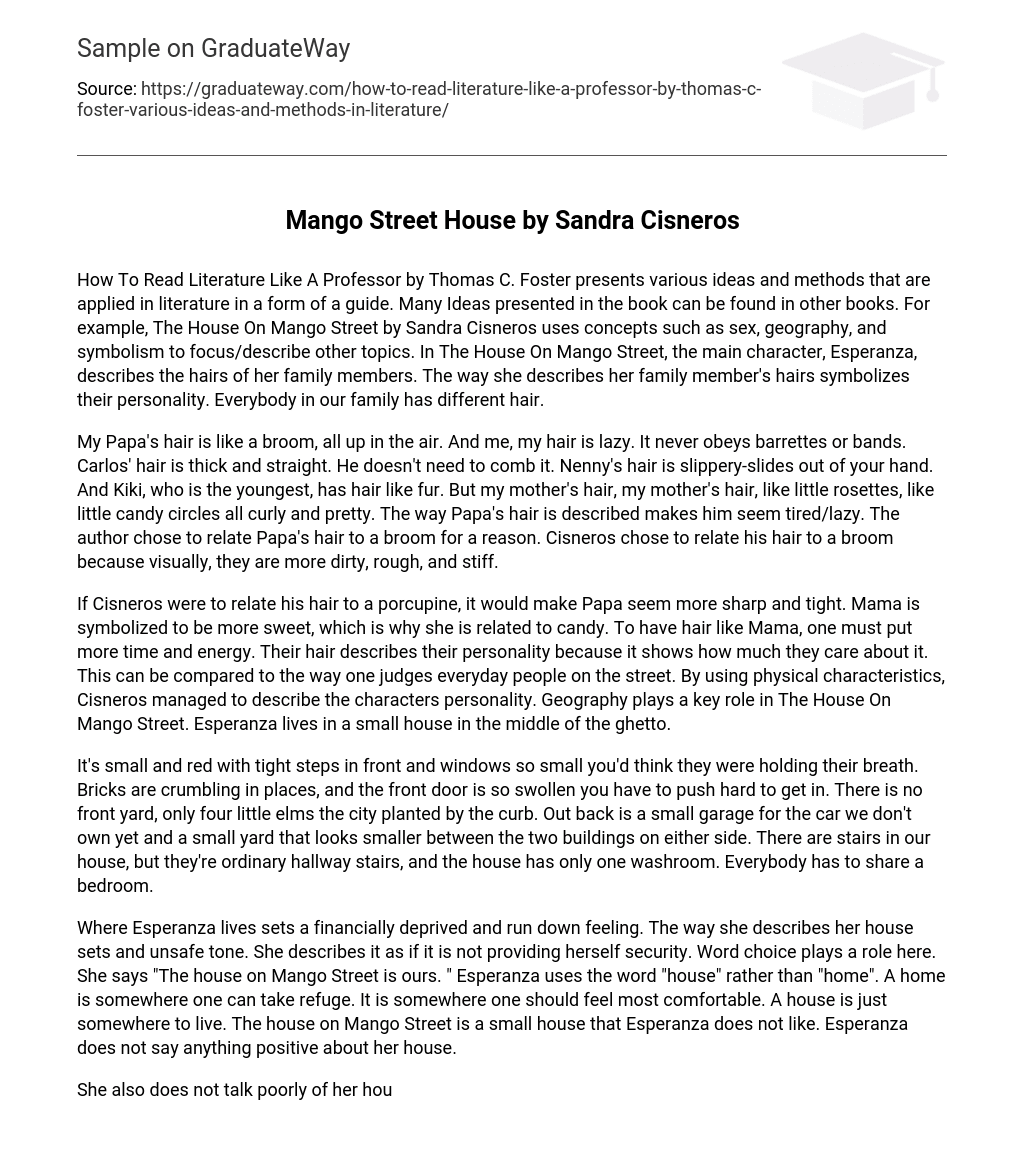How To Read Literature Like A Professor by Thomas C. Foster presents various ideas and methods that are applied in literature in a form of a guide. Many Ideas presented in the book can be found in other books. For example, The House On Mango Street by Sandra Cisneros uses concepts such as sex, geography, and symbolism to focus/describe other topics. In The House On Mango Street, the main character, Esperanza, describes the hairs of her family members. The way she describes her family member’s hairs symbolizes their personality. Everybody in our family has different hair.
My Papa’s hair is like a broom, all up in the air. And me, my hair is lazy. It never obeys barrettes or bands. Carlos’ hair is thick and straight. He doesn’t need to comb it. Nenny’s hair is slippery-slides out of your hand. And Kiki, who is the youngest, has hair like fur. But my mother’s hair, my mother’s hair, like little rosettes, like little candy circles all curly and pretty. The way Papa’s hair is described makes him seem tired/lazy. The author chose to relate Papa’s hair to a broom for a reason. Cisneros chose to relate his hair to a broom because visually, they are more dirty, rough, and stiff.
If Cisneros were to relate his hair to a porcupine, it would make Papa seem more sharp and tight. Mama is symbolized to be more sweet, which is why she is related to candy. To have hair like Mama, one must put more time and energy. Their hair describes their personality because it shows how much they care about it. This can be compared to the way one judges everyday people on the street. By using physical characteristics, Cisneros managed to describe the characters personality. Geography plays a key role in The House On Mango Street. Esperanza lives in a small house in the middle of the ghetto.
It’s small and red with tight steps in front and windows so small you’d think they were holding their breath. Bricks are crumbling in places, and the front door is so swollen you have to push hard to get in. There is no front yard, only four little elms the city planted by the curb. Out back is a small garage for the car we don’t own yet and a small yard that looks smaller between the two buildings on either side. There are stairs in our house, but they’re ordinary hallway stairs, and the house has only one washroom. Everybody has to share a bedroom.
Where Esperanza lives sets a financially deprived and run down feeling. The way she describes her house sets and unsafe tone. She describes it as if it is not providing herself security. Word choice plays a role here. She says “The house on Mango Street is ours. ” Esperanza uses the word “house” rather than “home”. A home is somewhere one can take refuge. It is somewhere one should feel most comfortable. A house is just somewhere to live. The house on Mango Street is a small house that Esperanza does not like. Esperanza does not say anything positive about her house.
She also does not talk poorly of her house though. It is as if she is used to it. The setting describes Esperanza’s attitude and the danger around her neighborhood. Later in the novel, Esperanza gets raped. The scene is about rape but it is not focused on the rape itself. The scene is focused on the surroundings instead. For example, while the rape is occurring, the author chose to focus on her helplessness. While she was being raped, Esperanza was overwhelmed. She saw clowns standing around her laughing, she saw the moon as if it was watching her. It focused on how she could not do anything. Then the colors began to whirl. Sky tipped. Their high black gym shoes ran. Sally, you lied, you lied. He wouldn’t let me go. ” The rape scene also focuses on the negative side of sex. Sex is often portrayed to be good. The way Esperanza says “Sally, you lied” says that Sally informed Esperanza that sex would be good. There are many messages and ideas behind every novel. Authors hide these ideas through books using other concepts and techniques, such as sex, geography, and symbolism. The House On Mango Street can be dissected and one can find many other messages other than the ones written.





